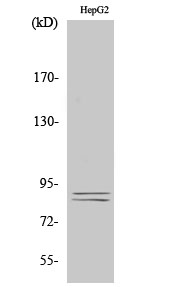Phospho IKK-α (S176) /IKK-β (S177) Cell-Based Colorimetric ELISA Kit
- Catalog No.:KA1259C
- Applications:ELISA
- Reactivity:Human;Mouse;Rat
- Gene Name:
- CHUK/IKBKB
- Human Swiss Prot No:
- O15111/O14920
- Storage Stability:
- 2-8°C/6 months
- Detection Method:
- Colorimetric
- Background:
- catalytic activity:ATP + [I-kappa-B protein] = ADP + [I-kappa-B phosphoprotein].,enzyme regulation:Activated when phosphorylated and inactivated when dephosphorylated.,function:Acts as part of the IKK complex in the conventional pathway of NF-kappa-B activation and phosphorylates inhibitors of NF-kappa-B thus leading to the dissociation of the inhibitor/NF-kappa-B complex and ultimately the degradation of the inhibitor. As part of the non-canonical pathway of NF-kappa-B activation, the MAP3K14-activated CHUK/IKKA homodimer phosphorylates NFKB2/p100 associated with RelB, inducing its proteolytic processing to NFKB2/p52 and the formation of NF-kappa-B RelB-p52 complexes. Also phosphorylates NCOA3. Phosphorylates 'Ser-10' of histone H3 at NF-kappa-B-regulated promoters during inflammatory responses triggered by cytokines.,PTM:Phosphorylated by MAP3K14/NIK, AKT and to a lesser extent by MEKK1, and dephosphorylated by PP2A. Autophosphorylated.,similarity:Belongs to the protein kinase superfamily.,similarity:Belongs to the protein kinase superfamily. Ser/Thr protein kinase family. I-kappa-B kinase subfamily.,similarity:Contains 1 protein kinase domain.,subcellular location:Shuttles between the cytoplasm and the nucleus.,subunit:Component of the I-kappa-B-kinase (IKK) core complex consisting of CHUK, IKBKB and IKBKG; probably four alpha/CHUK-beta/IKBKB dimers are associated with four gamma/IKBKG subunits. The IKK core complex seems to associate with regulatory or adapter proteins to form a IKK-signalosome holo-complex. Part of a complex composed of NCOA2, NCOA3, CHUK/IKKA, IKBKB, IKBKG and CREBBP. Part of a 70-90 kDa complex at least consisting of CHUK/IKKA, IKBKB, NFKBIA, RELA, IKBKAP and MAP3K14. Directly interacts with IKK-gamma/NEMO and TRPC4AP (By similarity). May interact with TRAF2. Interacts with NALP2. May interact with MAVS/IPS1.,tissue specificity:Widely expressed.,
- Function:
- morphogenesis of an epithelium, morphogenesis of an epithelial sheet, immune system development, leukocyte differentiation, myeloid leukocyte differentiation, protein amino acid phosphorylation, phosphorus metabolic process,phosphate metabolic process, immune response, intracellular signaling cascade, protein kinase cascade, I-kappaB kinase/NF-kappaB cascade, I-kappaB phosphorylation, phosphorylation, hemopoiesis, myeloid cell differentiation,osteoclast differentiation, odontogenesis of dentine-containing tooth, odontogenesis, hemopoietic or lymphoid organ development, tissue morphogenesis, epithelium development,
- Subcellular Location:
- Cytoplasm . Nucleus . Shuttles between the cytoplasm and the nucleus.
- Expression:
- Widely expressed.
- June 19-2018
- WESTERN IMMUNOBLOTTING PROTOCOL
- June 19-2018
- IMMUNOHISTOCHEMISTRY-PARAFFIN PROTOCOL
- June 19-2018
- IMMUNOFLUORESCENCE PROTOCOL
- September 08-2020
- FLOW-CYTOMEYRT-PROTOCOL
- May 20-2022
- Cell-Based ELISA│解您多样本WB检测之困扰
- July 13-2018
- CELL-BASED-ELISA-PROTOCOL-FOR-ACETYL-PROTEIN
- July 13-2018
- CELL-BASED-ELISA-PROTOCOL-FOR-PHOSPHO-PROTEIN
- July 13-2018
- Antibody-FAQs

